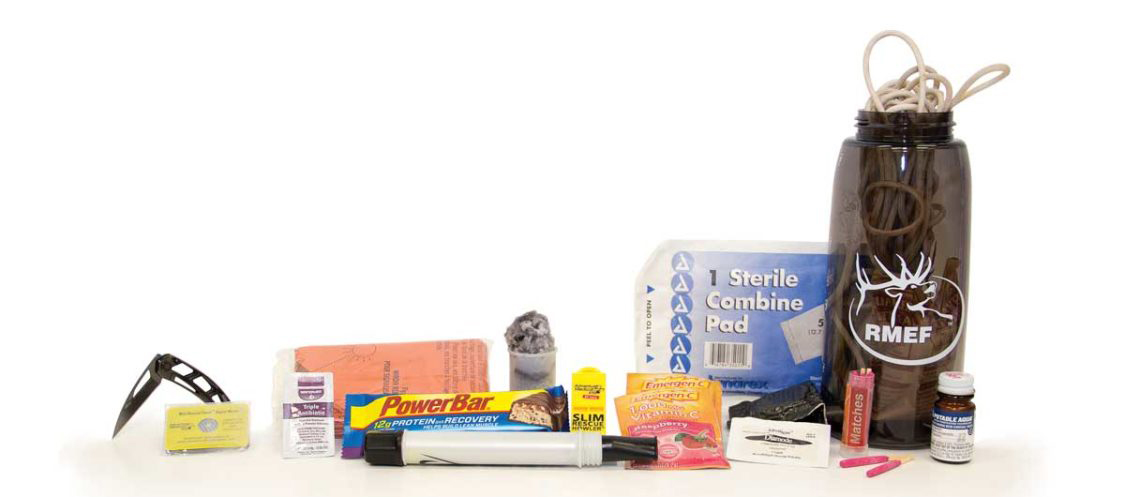Do What You Can with What You Have
It’s wise to carry first-aid supplies in your hunting pack, and I strongly advise that you do. But let’s face it, sometimes we don’t. Or we wind up needing something we didn’t carry. The reality is that injuries do happen, and you’re fortunate if you have hunting partners to help you cope. But to be best prepared, you should be in the mind-set of “self-aid” when considering first aid. A few basic concepts, some creativity, grit and perseverance can overcome many unexpected challenges.
Injury 1: Day hunt away from camp, where you left the first aid kit. You are alone and have an elk down. While processing the elk into pieces for packing, you cut your finger.
Treatment: First, stop the bleeding with direct pressure and flush the wound with water. If it is a large or deep incision, you can flush it by filling a plastic baggie with water and poking a hole in one corner, then squeezing the bag to create a jet of water. Dr. Don Thomas, an experienced backcountry guide and M.D. points out, “The absolute sterility of the water is less important than high-volume rinsing to get dirt out of the wound.” To bandage, you can wrap with a strip of t-shirt or other absorbent material and secure it with duct tape until you get back to camp.
Injury #2: Same scenario as above, but you plunge the knife midway into your inner thigh.
Treatment: This is still a laceration and can be treated with direct pressure to stop bleeding. However, an additional concern is the possibility of cutting part of a femoral artery, which runs over the pelvic bone on both sides and into each leg. If this happens, there will be a strong flow of blood that direct pressure might not conquer alone. Pushing hard on the pressure point located at the “bikini line” on the front of the pelvis, midway across the thigh, can help stem bleeding but must be augmented by direct pressure on the wound site. In a single-person scenario, a constriction band (improvised with a belt or wide piece of material bound tightly, on the pressure point) can allow you to then pack the wound firmly with absorbent material and wrap tightly with something to secure the packing in place. A constriction band is NOT a tourniquet, which stops all flow of blood to the limb. Rather, it is like a second set of hands to put pressure on the artery while you package the wound.
Injury #3: While in camp preparing a meal, you grab a hot, metal pot handle and burn your hand. The skin is red and begins to form blisters after an hour or so. It is painful and sensitive to touch.
Treatment: You likely have a second-degree burn. Flush thoroughly with cold water. If blisters break, remove loose skin. Apply antibiotic ointment. Avoid adhesive bandages that will pull at the skin. Wrap the affected area completely (but not tightly) with a light, absorbent covering to prevent contamination. Change dressing once per day.
Injury #4: During a hike between camp and your vehicle, you twist your ankle on unstable rocks.
Treatment: If it is painful but possible to walk, then support your ankle by wrapping it tightly in a 90-degree position with tape or an ACE-type bandage. If you cannot bear weight on it, you should assume a fracture and splint the joint. The splint should be padded and extend from mid-calf to the bottom of the foot on both sides of the leg. Any rigid material can serve as a splint. Consider using stout tree limbs wrapped in extra pieces of clothing or game bags. Secure by wrapping evenly over the entire length of the splint. Loosen your boot to allow for swelling and proper circulation, and avoid wrapping too tightly as the injury will swell. Dr. Thomas points out that the elasticity of ACE-style bandages are an advantage here as they “give” to allow for swelling. Find a strong walking stick to help with balance and reduce pressure on the foot. Take the load off your back and keep your survival gear with you. Seek medical attention as soon as possible.
Injury #5: You and your partner are hiking together. Your partner slips on a log while crossing a creek, falling onto the sharp end of a broken branch, which punctures their chest cavity.
Treatment: If you hear a sucking sound or see bubbles at the wound site when your partner breathes, this usually indicates a punctured lung. Seal the wound with anything airtight, like a plastic sandwich baggie, by securing it on three sides with tape. This will act as a one-way valve. When your partner inhales, it will seal; when they exhale, it will allow air to escape. If you don’t have plastic, a gauze pad impregnated with petroleum jelly or antibiotic ointment will also work. Go to a medical facility immediately.
Injury #6: A person in your hunting party is bucked off a horse and hits their head on the ground, resulting in unconsciousness.
Treatment: Bleeding from the scalp is likely and can be treated with direct pressure and bandaging. However, there is the possibility of a concussion, skull fracture and brain injury. Ensure your partner has an adequate airway. Take their vitals to see if they’re alive. Examine the skull with your fingers. If it feels “mushy” and/or there is bruising and discoloration around the eyes, assume a brain injury and evacuate to a medical facility immediately. If the unconsciousness is brief and your partner is able, they can walk out with assistance. If they become uncoordinated or do not act normally, transport them out of the backcountry.
John Solomon is a former U.S. Air Force Survival Instructor, and he teaches hunter education, instructor training, and survival skills workshops for the New Mexico Department of Game and Fish.
